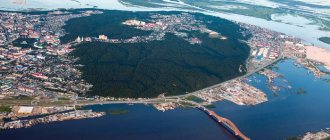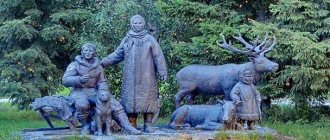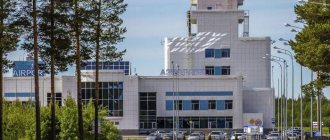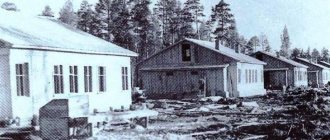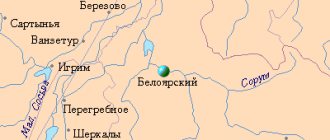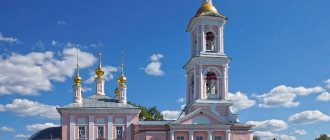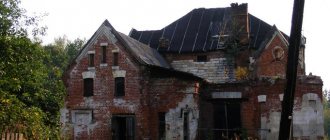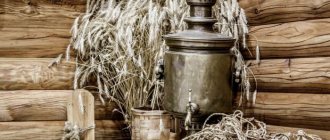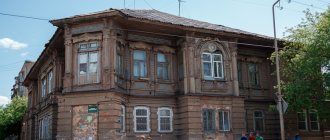Khanty-Mansiysk
History of Khanty-Mansiysk
The origins of the history of the peoples of Ugra go back to the late Ice Age, when moving ice formed the flat landscape of Western Siberia.
Traces of Paleolithic people have been found on the territory of the national district. The oldest sites found appeared about 12-15 thousand years ago. Within Khanty-Mansiysk, archaeologists recently excavated a settlement of the ancestors of the Khanty and Mansi, which was discovered in a landslide on the slope of a hill. The settlement existed in the IV-VI centuries. Fragments of ceramic dishes, bronze knives, copper hammers, stone needles, remains of hearths and animal bones were found in the cultural layer. In total, more than 1,000 artifacts were collected. The finds can be viewed at the local history museum. Researchers found that the main occupation of the local population was hunting and fishing, and raising livestock.
In the XII-XIII centuries, the Belogorsk Khanty principality was formed at the confluence of the Irtysh and the Ob. According to local legends, on its territory there were important sanctuaries in which shaman-fortune-tellers lived. The capital of this state entity was a town fortified with a spruce palisade, which existed on the banks of the Irtysh not far from modern Khanty-Mansiysk. In the last quarter of the 16th century, Khanty Prince Samar ruled here.
In 1583, Cossack troops of Ataman Ermak, armed with firearms, reached these places. Although the city’s defenders had only archaic bows and spears in their arsenal, they put up desperate resistance to the invaders. After storming the wooden fortifications, the surviving warriors of Prince Samar surrendered to the victors. The Khanty ruler himself died in battle.
By the 17th century, Russian colonists were actively moving across the expanses of conquered Western Siberia. In 1637, in the city of Samarovo, which bears the name of the legendary prince, a center for horse-drawn carriage arose - the Samarovsky pit. Hundreds of coachmen settled here, delivering mail and passengers along the taiga roads. In 1775, Empress Catherine II signed a decree creating the Tobolsk province. It included the lands of the Khanty and Mansi.
At the turn of the 19th-20th centuries, a telegraph line was installed in Samarovo. There was a pier here for trade and passenger ships plying along the Irtysh and Ob. In 1930, by decision of the Soviet government, the Ostyak-Vogul National Okrug (Khanty-Mansiysk National Okrug - Ugra) was allocated in the Tyumen region. The following year, construction of the district center began. A settlement called Ostyako-Vogulsk was founded 3 km from the village of Samarovo, on the northern slope of the Samarovo hill. About 37,000 special settlers from Ukraine, the Volga region, and the Urals were sent here. In 1940, the settlement received its modern name.
In the 1950-1960s, colossal oil and gas fields were discovered in the Khanty-Mansiysk National District. This gave a powerful impetus to the development of the capital of Ugra, which became the central base for geological exploration expeditions and oil workers' shift teams. Drillers discovered mineral water sources near Khanty-Mansiysk, and in 1953 a balneological sanatorium began to welcome guests in the Valley of Streams. A river port and a bus station were built in the city, and a passenger terminal was built at the nearby airport, which had existed since the 1930s. Modern buildings, hotels, offices of oil and gas companies, shopping and cultural centers appeared on the streets. In 2001, the first students were admitted to Ugra State University.
Back in 1996, the construction of an asphalt highway was completed, connecting the capital of the district with the largest cities of the autonomy - Surgut, Nefteyugansk, as well as with the regional center - Tyumen. In 2004, a road bridge was built across the Irtysh River. The width of its span over the navigable fairway was 231 m. By the beginning of the 2020s, the population of Khanty-Mansiysk exceeded 100,000 inhabitants.
Geography and nature
Khanty-Mansiysk is located within the West Siberian Plain, on the right bank of the Irtysh River. The city is located 12 km upstream from the confluence of this waterway with the Ob. Khanty-Mansiysk was built at the eastern foot of the 80-meter Samarovskaya Mountain and several lower hills. These hills (remnants) were formed by glaciers approximately 250 thousand years ago. The slopes of the foothills are covered with dense cedar forests and centuries-old spruce trees. In 1984, 420 hectares of suburban taiga were declared a natural monument. In the mid-1990s, a track with shooting ranges for biathletes was built on the slope of one of the hills in the park. International skiing competitions take place here. In the north-west of the reserve forest there is the ethnographic museum “Torum Maa”, where folklore concerts and theatrical festivals are held.
There are ecological trails in the picturesque area. At the end of May, as soon as the snow cover melts, groups of tourists on foot appear in Khanty-Mansiysk. Especially many travelers head to the wooded slopes in July and August, when the season for picking wild berries and mushrooms begins.
The flora in the region is typical of Western Siberia: coniferous trees, larches, and mosses reign here. In the taiga there are plants characteristic of the forest cover of the subpolar Urals. In the floodplains of the rivers - and there are more than 2000 of them in the national district - alder and birch groves grow green. To the northeast lie vast swampy taiga and tundra plains crossed by rivers. In the tundra, the vegetation is stunted, which is affected by the permafrost hidden under the thin cover of the soil. Northern berries grow in abundance in the swamps: cloudberries, blueberries, blueberries. Lichens serve as food for herds of deer. More than 60 species of mammals live here. Among them are bears, moose, wolves, pine martens, and wild boars. There are foxes and hares, sables, and ermines. Beavers and otters live in the rivers. There are up to 256 species of birds in the taiga. Local residents hunt geese, ducks, woodcock, and hazel grouse.
The river fauna of the Irtysh, Ob and other rivers and lakes of the region is rich, home to more than 40 species of fish. The desired catch of fishermen is sterlet, whitefish, burbot, pike, and ide. Rare species include sturgeon, nelma, taimen, and muksun.
Climate
Khanty-Mansiysk is located in a temperate continental climate with sharp temperature changes. This feature manifests itself mainly during the transition from autumn to winter, as well as with the onset of spring thaws.
In terms of climatic conditions, some of the districts of the national district are equal to the regions of the Far North. Arctic air masses coming from the Arctic Circle circulate freely across the plains of Western Siberia. The average air temperature in January and February is –24…–19 °C. Despite the fact that in winter the south wind prevails here, during this period the columns of street thermometers in Khanty-Mansiysk often drop to -32...-28 °C below zero. In January 1964 and 1968, the city experienced extreme frosts down to –49 °C. And in December 2016, a record temperature was recorded at the weather station of the Beloyarsk region of autonomy: –62 °C.
Spring comes to the region in the first half of May, when during the day the air warms up to +3...+4 °C, but at night it still freezes. Summer in the city is short but relatively warm. From May to July, white nights are observed in the capital of Ugra. In June-August in Khanty-Mansiysk it is usually +18…+20 °C. However, July 2022 surprised Ugra residents with heat reaching +34.7 °C.
Sights of Khanty-Mansiysk
Khanty-Mansiysk, founded in the last century, cannot boast of ancient iconic buildings. At the same time, it differs from many cities built during the Soviet period. Due to difficult geological conditions in that era, the city avoided mass development with dull five-story Khrushchev-era buildings. Here buildings were erected according to individual designs, taking into account the permafrost under the foundations.
On the streets of Khanty-Mansiysk you can also see original buildings by modern architects, surprising with their unusual design. These include, for example, the recently erected buildings of city museums. Tourists arriving in the city by air immediately notice the memorable silhouette of the airport terminal with an octagonal pyramid made of green glass, reminiscent of a tent tent.
City squares and gardens are decorated with monuments and nice sculptures. Many monuments were erected quite recently. In 2010, a monument to the founders of the city was erected in front of the entrance to the Church of the Intercession of the Blessed Virgin Mary; it rises two steps from Freedom Square. On a stylized rocky ledge stand the heroic figures of Prince Samar and the Moscow governor Ivan Mansurov, who founded a fort at the confluence of the Irtysh and the Ob. Above the statues rises an arch symbolizing the gates to Siberia.
In the center of Khanty-Mansiysk, opposite the district government building, a rotunda with a fountain attracts attention. On holidays, its columns are surrounded by garlands of lights, and a New Year tree is erected here.
Within the city limits, on Obezdnaya Street, there is the Samarovsky outlier - a low mountain, the origin of which represents a geological puzzle. The mysterious mountain is not monolithic; its depths consist of huge individual blocks of stones, as if a giant bulldozer had shoveled them into a conical hill. It is surprising that the remnant contains rocks that have not been found anywhere else in this region. Among them are rock crystal druses, mica plates, quartzite boulders, fragments of jasper, marble, and granite. How they got to the flat bank of the Irtysh is a mystery. Some scientists believe that this “stone mix” was brought by a glacier moving from the mountain ranges of the Northern Urals, while others put forward other hypotheses. The entire diversity of rocks in the remnant is exposed in a specially made vertical section of the mountain slope. Local guides conduct excursions here for curious tourists.
In 2007, at the foot of the outcropping, an archeopark was created with impressive figures of animals that lived in Western Siberia hundreds of thousands of years ago, during the Pleistocene era. Sculptor A. Kovalchuk, who created this prehistoric menagerie, consulted with paleontologists, and sculpted all the figures with scientific precision. The impression is enhanced by the recreated prehistoric landscape. A line of 11 mammoths wanders along the mountainside. At the head of the herd, an 8-meter giant with huge curved tusks slowly steps. There are dynamic sculptures of bison and a wolf pack, reindeer, rhinoceroses, cave lion, and bear here. Nearby, a group of Paleolithic hunters is depicted.
Sculptural compositions of animals of the ancient fauna are replenished. Recently, a whole herd of man-made wild horses and beaver statues appeared in the park. You can get to the archeopark by bus No. 4, and minibus No. 16 also runs here.
At Mira Street, 11, there is the Museum of Nature and Man. The local history exhibition presents local nature, the traditional life of the Khanty and Mansi peoples, their myths and legends. The halls introduce visitors to the history of the region in chronological order, from the Neolithic era to the development of oil and gas fields in the 20th century. A separate room is dedicated to special settlers sent here during the period of Stalinist repressions.
A variety of exhibits are grouped at separate thematic exhibitions. The collection of weapons includes antique flintlocks, pistols, and sabers. From their personal archives, local residents donated more than 60,000 photographs to the museum, depicting the life of peasants from the beginning of the last century. A collection of icons and carved church sculptures has been collected. Unique archaeological artifacts attract attention - bronze mirrors created in the early Iron Age, the anthropomorphic figure of Vut Imi, the goddess of the Kazym River, decorated with silver inserts. There is also a perfectly preserved skeleton of a giant elephant that lived in the Irtysh valley hundreds of thousands of years ago, before the onset of the Ice Age. In the showcase of the paleontological section you can see another rare exhibit - a mammoth vertebra, pierced by a stone ax or spear. According to radiocarbon dating, this successful hunt by the primitive inhabitants of Western Siberia took place 14,500 years ago.
Tickets to the exhibitions are sold for 150 rubles. It is more profitable to purchase a single ticket for the inspection for 250 rubles. Children under 18 years of age are admitted free of charge. If you wish, you can join a tour of the halls (150 rubles per person). The museum is open from 11:00 to 19:00, you can have a snack in the cafe. City buses No. 5, 77 and minibuses No. 7, 13, 16, 21, 26 stop not far from the entrance.
The natural resources of the region are presented in the Museum of Geology, Oil and Gas (Chekhova St., 2). Here you can find samples of rocks, collections of semi-precious stones, and valuable ornamental stones. Jewelry made from them can be viewed at the jewelry exhibition. Paleontological finds attract attention. In the halls of scientific and technical achievements, samples of mining equipment and drilling rigs are exhibited, breaking through kilometers of earthly rocks to mineral deposits.
It is interesting to explore the exhibition accompanied by a guide. An hour and a half sightseeing tour will cost 250 rubles per person. The shop at the entrance sells souvenirs made from various minerals. The museum doors are open from 11:00 to 18:00, Monday and Tuesday are days off. The entrance ticket costs 170 rubles.
A magnificent building for the exhibition of the State Art Museum was built in Khanty-Mansiysk (Mira St., 2). Here are collected paintings by outstanding Russian artists - Aivazovsky, Polenov, Vasnetsov, Levitan. A separate room is occupied by a rich collection of icons. Many paintings were purchased by oil and gas companies at international auctions and donated to the museum. The collection is replenished by patrons and the government of the autonomy. Next to the museum is the Faberge fountain. In the center of the pond, made of pink granite, there is a huge copy of a luxurious Easter egg from the famous jewelry house. Bronze details and colored smalt mosaics were used in the decoration. In the evenings, the composition is effectively illuminated by spotlights.
Two steps away, on a hill, stands the Cathedral of the Resurrection of Christ. The temple is surrounded by a landscaped park with cascading stairs. Opposite the entrance to the temple there is a “10 Commandments” fountain. Along the perimeter of the round reservoir there are bronze tablets with Old Testament commandments. There is an observation deck near the walls of the cathedral, which offers impressive views of Khanty-Mansiysk, the waters of the Irtysh and taiga forests. It's nice to stroll here at any time of the year.
Beaches
By mid-summer, the water temperature in the Irtysh River in the Khanty-Mansiysk region reaches +18...+20 °C, which is quite comfortable by Siberian standards, which is comparable to the air temperature during this period. It is worth considering that the swimming season here lasts only a few weeks, and midges and mosquitoes do not allow vacationers to soak up the sun to their heart's content.
There are no equipped recreation areas near the water here, although local authorities once tried to develop a civilized city beach. In 2012, a beach area with canopies, sun loungers, children's slides and swings appeared on the banks of the Irtysh. There were rescuers on duty at the towers, and there was a rental office for sports equipment and parking for cars. The following spring, another ice drift and flood on the Irtysh destroyed beach facilities, costing the municipal budget 5 million rubles.
In warm weather, you can swim in any convenient place on the river coast. On the city Internet forum and on social networks, Ugra residents inform each other about such locations. For example, in June and July 2021, citizens swam in the river port area and went on picnics to the surrounding rivers, where the water was reportedly a little warmer.
Entertainment
In 2004, a modern concert and theater complex “Ugra-Classic” with an area of 20,000 m² was built in the city (Mira St., 22). There are several concert halls here, including an organ hall with seating for 200 spectators. In the complex you can watch performances, stroll through art salons, and visit a film club. The galleries display works of art, and the club restaurant welcomes guests. The country's leading theaters and popular Russian pop artists often tour at Ugra-Classic. Opposite the museum there is an allegorical statue of the Golden Goddess with a stylized Sun tambourine in her hands. Nearby there is a city park with interesting park sculptures on the alleys.
In the open-air ethnographic museum “Torum Maa”, according to the annual cycle of local peoples, holidays and rituals are held. In February, March, April, on full moon days in the evenings, it is interesting to look at the ancient ritual “Tyloshch Pori”, when the elders present gifts to the Moon deity - figurines of horses, cows, and deer baked from dough. Accompanied by the chant of prayers addressed to the Moon and the forest spirits, treats are placed on a table made of snow. At the beginning of April, the spring holiday “Raven Day” is traditionally celebrated, and on June 1, Mansi Fr. During these periods, the museum organizes theatrical performances, competitions, and master classes.
Khanty-Mansiysk is famous for winter fun. Before the New Year holidays, the colorful Chumovaya Street opens here, where pointed tents and spacious yurts are located - the traditional dwellings of the indigenous Siberian peoples. Fires are blazing in the hearths, meat is browning on braziers, tantalizing aromas are wafting from boiling pots: the gastronomic festival of national cuisine “Taste Ugra” is being held on Chumovaya. There are sleigh rides pulled by reindeer or a whole pack of sled dogs. On the Alley of Snowmen, everyone can fashion their own composition out of snow. The jury evaluates the works and awards prizes to the creative winners. Extreme sports enthusiasts take part in Siberian spa treatments - jumping out of a hot bathhouse, throwing themselves into a snowdrift and running back to the steam room.
Purchases
The largest trading companies, “Meridian”, “Sky”. The selection of manufactured goods in Khanty-Mansiysk stores is small. Local residents go to neighboring Surgut for fashionable new things. But tourists will certainly find wonderful souvenirs in the capital of Ugra. Indigenous peoples have long been famous for their skill in processing leather and fur, carving bone, stone and wood, and making pottery.
It is worth visiting the Center for Folk Arts and Crafts (Roznina St., 119), the Orpheus art salon (Chekhova St., 85/2), and the art salon “Artists of Ugra” (Sportivnaya St., 24). These stores offer stylish winter clothing - fur coats, hats, mittens. High boots - soft leather boots with reindeer fur - are especially in demand. Ladies will love bags and accessories embroidered with beaded patterns.
Fabric dolls-amulets and various amulets are popular among tourists. To decorate the interior of the living room, you can purchase figurines of mammoths, shamanic tambourines, and landscape paintings embroidered with satin stitch.
Tourists also bring edible souvenirs from Khanty-Mansiysk, for example, delicacies made from muksun, a Siberian river fish of the salmon family. Dried and smoked venison and mushroom pickles are delicious. At the market you can buy frozen venison stroganina - thin slices of raw meat marinated with spices.
Cafes and restaurants
Fifty restaurants, pubs and cafes await guests in Khanty-Mansiysk. In most establishments the prices are quite high, but in the city you can also find quite budget canteens, pizzerias, and snack bars.
A recognized center for tasting national cuisine is the Misne restaurant. The stylish establishment is located in the hotel complex of the same name, built in a park on Gagarina Street, 54. The signature dish is expertly prepared venison, stewed in a sauce with porcini mushrooms. Order a “fisherman’s frying pan” and try several types of delicious fish at once - fried fillet of sterlet, muksun, nelma, accompanied by pike caviar. They also serve dumplings and other dishes made from wild boar and elk meat, assorted fish soup from burbot, pike and crucian carp, duck breasts with apples, pickled milk mushrooms, pickles and other taiga delicacies. Special delicacies include elk pates and roast bear meat. The menu includes home-made strong drinks, infusions of pine nuts, berries, and aromatic herbs. The price range for main courses is from 140 to 500 rubles. Please note: prices for many dishes are indicated not per serving, but per 100 grams.
And the one on Dzerzhinsky Street, 13, is another premium restaurant in Khanty-Mansiysk. The interiors of the establishment are decorated in Provence style, and there is live music. The menu is dominated by Caucasian cuisine; the grill is located in the center of the main hall. Prices here are quite high, the average bill is 3,000 rubles per person. From 12:00 to 16:00 clients are given a 20% discount on business lunches. Very nearby, on Dzerzhinsky Street, 5-A, is “Kinza”, another restaurant of Caucasian cuisine. The kebabs, lamb kebabs, kharcho, and fried chicken are excellent here. Author's desserts and cocktails are offered. "Kinza" operates as a nightclub. The feast will cost 4500-5000 rubles per guest (including drinks). The doors of the establishment are open from noon to 3 am.
In the building of the river station on the banks of the Irtysh, the Poseidon restaurant awaits guests. It's usually not crowded here. The dining room is located on the 2nd floor, with views of the river. Seafood dishes from river catch are offered. In the meat section of the menu you will find stewed and fried game dishes: wild boar, elk, deer, quail. The price range for main items is 500-2000 rubles. The restaurant is open daily from 12:00 to 02:00.
The chefs of the Assorted pizzeria café, located in the park on Mira Street, 13, cook delicious food. There is a room with a self-service counter and a room with à la carte service. According to customer reviews, the choice of dishes and service are at a decent level. Sausage and cheese slices are served with beer. The price range on the menu is 180-550 rubles.
In Khanty-Mansiysk, for breakfast, go to the Traveler's Coffee cafe on Lenina Street, 39. The doors of the establishment are open from 07:00. Light dishes are offered here: cottage cheese pancakes with cherry sauce, omelette with salmon, sandwiches, appetizers, salads. There is a vegetarian menu. If you wish, you can order a larger breakfast: Bavarian sausages with potatoes, Italian pasta. The range of drinks includes juices and fruit drinks, several types of coffee and tea. Alcohol is not served here.
You can have an inexpensive lunch at the Nazymchanka self-service canteen (10 Stroiteley St.). A three-course lunch with tea and pastries will cost 400-450 rubles.
Where to stay
The capital of oil-bearing Ugra has a good selection of hotels. There are about 60 hotels, mini-hotels, and private apartments for rent in the city. The building of the Olimpiyskaya Hotel was built in 2010 specifically to accommodate participants in the international chess Olympiad held in Khanty-Mansiysk. Business center offices, a fitness club, a beauty salon, a solarium, and a billiard room are open to guests. There is a restaurant, the lounge bar offers all kinds of drinks, sandwiches, salads, and hot dishes. The buffet has a children's menu. The rooms are equipped with modern TVs, safes, refrigerators. The price range for daily accommodation is 9,000 – 18,000 rubles. Breakfast (buffet) is included in the price.
The cozy Misne Hotel is built in a forest park near the center of Khanty-Mansiysk, on Gagarin Street, 54. The air here is filled with the smell of pine needles, and there are gazebos with barbecues on the territory. We offer walking tours through the suburban hills covered with taiga forests, and car tours of the city accompanied by guides. 18 comfortable rooms are equipped with minibars, TVs, refrigerators, and air conditioners. The hotel has one of the best restaurants in Khanty-Mansiysk. The cost of living is 5600-6930 rubles.
Unpretentious tourists stay in the guest house “Vostok” (Vostochnaya St., 22). The rooms have kitchenettes, refrigerators, and TVs. Daily accommodation will cost 1496-2208 rubles.
The newly built Liner Hotel is located at the entrance to the city from the east, on Tobolsky Trakt Street. It is convenient to stay here before an early flight; the airport terminal is 3 minutes by taxi (1 km). The cost of a double room is 6200 rubles.
Small private hotels are located in the outskirts of the city. Prices there are much lower. For example, the roadside mini-hotel “Lesnaya”, built on the 38th kilometer of the Khanty-Mansiysk – Niagan highway, offers very inexpensive overnight accommodation. It is convenient for motorists to stay here; you can leave your car in free parking. They ask for 930 rubles for a room.
Booking.com
Transport
Public transport in the city is represented by buses and minibuses. Taxi services are also available. Regular buses from Tyumen, Nefteyugansk and other cities in the region arrive at the Khanty-Mansiysk bus station.
During river navigation, passenger ships ply along the Irtysh and Ob. By river transport you can get to Salekhard, Berezov, Igrim.
How to get there
Moscow is connected to Khanty-Mansiysk by regular flights. The flight lasts 3 hours 05 minutes. The airport of the capital of Ugra receives airliners from St. Petersburg, Tyumen, Chelyabinsk, Ufa, Yekaterinburg and other Russian cities.
The airport is located 5 km northeast of the center of Khanty-Mansiysk. Buses No. 5, 9-A, minibuses No. 11 and 16 depart from the arrival terminal to the city. A taxi ride will cost about 300 rubles.
It is impossible to get to Khanty-Mansiysk by rail. The nearest station is Pyt-Yakh, 258 km to the east. You can, for example, take a train to Surgut. From there, buses run daily to the capital of Ugra. Travel time – 5 hours 30 minutes.
Memorial sign to the discoverers of the Ugric land
Address of the Discoverers 1. From the Archeopark, turn left along the circular route. This is a huge pyramid, consisting of several faces, symbolizing several eras. It stands on a high hill, inside there is an observation deck, a zoo, a restaurant and submarine ships for a quest game. On the street behind the pyramid there is a beautiful view of part of the city, the river and the endless plain - the tundra stretching somewhere beyond the horizon. Entrance 300 rub. The elevator and now you can see the panorama, and most importantly it’s warm here, isn’t this happiness!!! Down on foot, there was a small zoo with monkeys, snakes and some other animals, we didn’t go to the restaurant, the quest didn’t work. Let's move on.
Biathlon center.
Address Karl Marx, 9. This is a sports facility that meets all international standards. Where biathlon and cross-country skiing competitions are held. In 2011, international biathlon competitions were held here. One of the stages of the Biathlon World Cup takes place every year. An iconic place. Unfortunately, it was already dark and very cold. It didn’t take long to wander around, we looked at the firing line, the stands and went to the hotel, in the morning to go on a patch to Surgut.
Khanty-Mansiysk made a very pleasant impression, if not for the weather and breakdown, we would have been able to see much more.
What to see in 2-3 days
Khanty-Mansiysk on the map of Russia occupies a vast territory and is famous for its variety of attractions. To make the most of your time, you need to create an excursion route.
1 day:
- Getting to know the city while walking along the “Ropeway”.
- Visit to the Archeopark and ride on reindeer.
- Visit to the Museum of Oil and Gas Geology.
- Skiing and tubing on the ski slope.
- Walk through the evening city, sightseeing: “Red Bridge”, “Faberge” fountain, “Rotunda” fountain.
Day 2:
- Inspection of the exhibition at the Torum Maa Museum.
- Skating.
- Sleigh ride.
- Inspection of the Church of the Resurrection of Christ.
- Evening walk around the city and inspection of the monuments: “The Hunt Family at a Rest”, “Bronze Symbol of Ugra”, “Monument to the Discoverers of the Ugra Land”.
Day 3:
- Inspection of the local archaeological site “Barsova Gora”.
- A walk through the natural attractions of the Khanty-Mansi Hills, Lake Arantur, Lake Sorovskoye.
- Visit to the Museum of Nature and Man.
Architectural landmarks
1. “Archeopark” in Khanty-Mansiysk is located in the southwest, at the foot of the “Pioneer Mountain”. This is a branch of the “Museum of Nature and Man”, organized in an open space of 4 hectares. The cliff of Pionerskaya Mountain, or rather the Samara outlier, is a world-famous geological object; “Samarov Town” is an archaeological monument.
The rocks sticking out of it are exposed ancient rocks. Sculptures of mammoths and representatives of ancient peoples installed at the foot of the park complement the unique atmosphere of the park. Near the territory of the Archeopark, a small area of taiga with an untouched landscape has been preserved.
2. Art Museum . Construction of the Art Museum building began in 2006, according to the design of the artist, Sergei Goryaev, and lasted almost 7 years. The design of the institution's style and logo was developed by Sergei and Natalya Lozovy, who were members of the Union of Designers of Russia. The opening took place in the summer of 2011. This building is recognized as an architectural landmark of Khanty-Mansiysk.
3. Orthodox complex. Erected according to the traditions of the 18th and 19th centuries, the building of the Orthodox complex “In the Name of the Resurrection of Christ” is of great value. This complex consists of 10 buildings. Nearby are architectural monuments of saints, sculptures on the theme of biblical commandments, and the park of literature and culture “Slavyanskaya Square”.
4. Theater "Sun" . The only theater in the world about the indigenous northern peoples, called “Theater of the Ob-Ugric Peoples Sun”, is famous throughout the world. It opened in early 2002 and immediately created a sensation. The actors perform in the native language of the Khanty and Mansi peoples and use throat singing techniques.
5. The natural and architectural park “Barsova Gora” has a length of almost 9 km along the right bank of the Ob River and rises 30 m above the river’s edge. For 7 thousand years people lived in this place. They left many valuable antiques, traces of their existence, which have been mined and studied by archaeologists over the past 100 years.
Ethnographic open-air museum “Torum Maa”
Address Konev 8, entrance 70 rubles. This is a recreated settlement of the peoples of the north. There are 3 compositions: summer standing, winter and sanctuary of the Ob Ugrians. Small wooden houses, boats made of wood, places where food supplies, skins, wooden idols were stored, all this is decorated with snowdrifts and covered with snow. It is very interesting to walk around and read the tables, BUT it is very cold and the excursion turned out to be very fast. The sun began to set, then we will go directly to the center, we will see the city with beautiful evening illumination.
